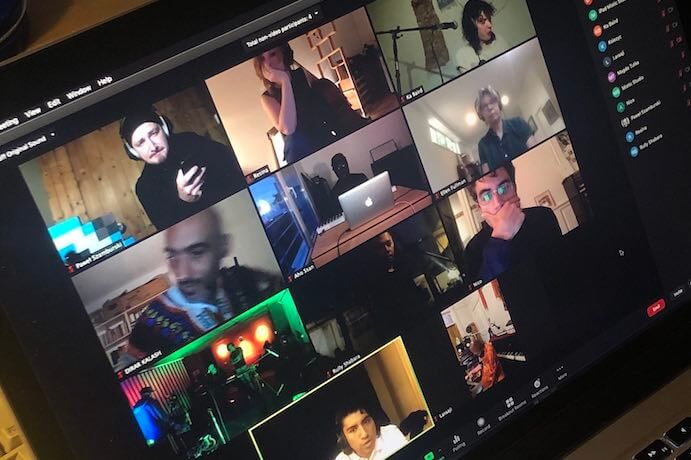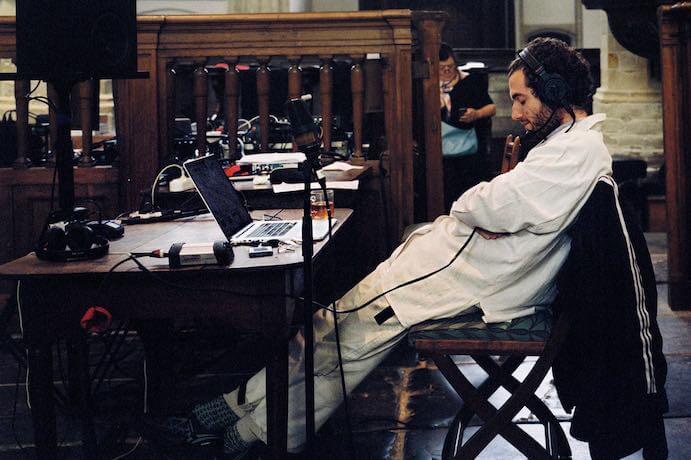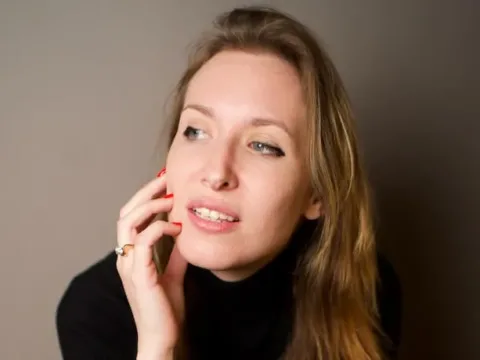Since its inception in 2003, Unsound Festival has become well known for its carefully curated, genre-bending concerts, which also include a custom perfume line. In the wake of the Covid-19 pandemic, the 2020 virtual festival commissioned a work by composer Nicolás Jaar, whose own work is known for living on the fringes of multiple genres and practices. Musicians had been faced with deciding how to create music in a remote context. Some leaned into solo performances. Others taught themselves how to remotely record people separately and stitch things together later. But Jaar’s solution for Unsound was to organize a host of collaborators – a real who’s who of experimental composers and performers including Angel Bat Dawid, Laraaji, Juliana Huxtable, and Paweł Szamburski, among others – to hardwire into an advanced audio plug-in, perform a long-form improvisation, and then mix the whole project in less than 24 hours before the premiere.
The collaboration, remastered since the original performance, now takes the form of a new album called Weavings, out now via Other People. Judged on its merits as a feat of technology and coordination, Weavings is a marvel. Judged as a pure work of musical expression, its only real shortcomings result from the required dependence on the internet.
Despite using an audio technology designed to reduce latency between musicians, the recording of Weavings still features small delays between what the instrumentalists could hear and how quickly they could react. The feeling of uneasiness that often comes with large group improvisations – those first few moments where everyone is testing out the waters and trying to ascertain what the vibe of the performance is going to be – lasts a little bit longer than necessary, making Part 1 among the weaker movements in the work. But despite any issues caused by latency, Part 1 does effectively set the tone for the performance.

Swells of clarinet drones are complemented by strings, mixed far in the background. There’s a sheen of echo across the whole track that invites the listener in. Just before the two minute mark, we hear the sound of a bell, which is in turn electronically manipulated, almost giving the sense that the computer might be failing. The album credits do not indicate who has performed which instrument; Part 1 is actually listed as “Aho Ssan, Angel Bat Dawid, Dirar Kalash, Ellen Fullman, Księżyc, Laraaji, Nicolás Jaar, Pawel Szamburski, Resina, Rolando Hernández Guzmán, Wukir Suryadi – Part 1,” lending some credence to the extremely collaborative nature of the project. Along those lines, it should be noted that Jaar is not listed on each track, which is something of a testament to his strengths as both a curator of musicians in this project and as a gracious bandleader who knows when to give space to his musical partners.
Any work that pushes the boundaries of technology in this way is bound to have some issues, so let the above be the only real criticism of how the limitations of internet connections get in the way of any of the music on Weavings. By the time we get to Part 2, the vast majority of those concerns have disappeared as a vocalist on a presumably improvised text gives way to a fluttering solo on an electric keyboard. Although the whole work was recorded in one segment, this digital release is divided into nine distinct tracks that do feel like well-conceived separate parts of a whole.
Part 3 is perhaps the most stylistically diverse – or as diverse as you can get in a piece that is, for all intents and purposes, one long drone. Crackles and bubbles in the fringes of the sonic space both demand your attention and complement the surrounding material, a great use of digital audio manipulation that isn’t quite matched across the rest of the album. These digital edits in Part 3 almost ruin the suspension of disbelief that Weavings is the product of one ensemble in one room, but they’re approached and mixed so cohesively that it doesn’t matter.

The relatively sparse Part 4 primarily features guitar and electronics. The track feels like possibly more of an interlude than anything else, but it’s a welcome change and something of a palate cleanser before the rest of the album. Part 5 reintroduces the vocalist with plenty of echo and delay against a backdrop of electric keyboards and synthesized groans. This is arguably the most dynamic section of music, and certainly the most rhythmic, leaving one wishing that this kind of texture would appear more, or even stick around for longer before returning to the drone soundscapes that dominate most of the album.
Parts 6-9 reference previous material in a way that makes the whole performance cyclical. The sparse texture laden with electronics in Part 6 is an analogue to 4, which makes the almost-groove of Part 5 a midway point. And if this is true, then Weavings can be heard as a kind of palindrome. Parts 7, 8, and 9 return to the drone-build of the beginning of the album, but they interact with musical material and improvisation in a very different way, and any uneasiness that came through in Part 1 is certainly gone by this latter half of the album.
Weavings would be getting a positive review from me regardless of the way in which it was performed and recorded. Improvised music at its best is thrilling when both the audience and the musicians have accepted a sort of social contract that the performance might not work out as intended. Everything is teetering on the edge of disaster, which makes a successful improvisation all the more exciting. What Jaar has achieved would be a triumph under regular circumstances – across the internet it’s almost a miracle. But at the end of the day, it’s the music – not the novelty of the technology – that matters. And this is by and large very good music.
I CARE IF YOU LISTEN is an editorially-independent program of the American Composers Forum, funded with generous donor and institutional support. Opinions expressed are solely those of the author and may not represent the views of ICIYL or ACF.
A gift to ACF helps support the work of ICIYL. For more on ACF, visit the “At ACF” section or composersforum.org.
























